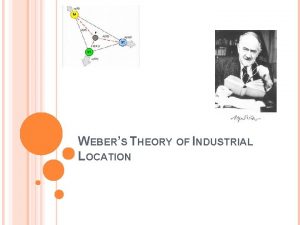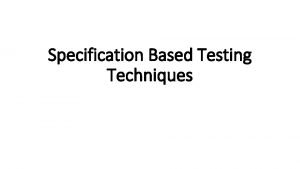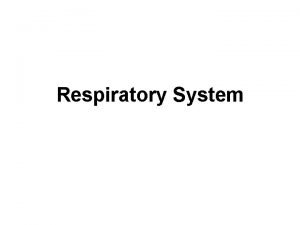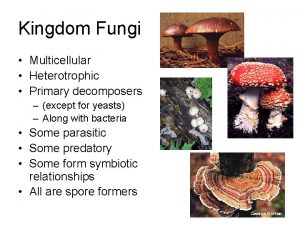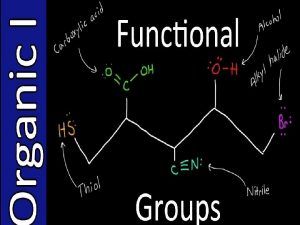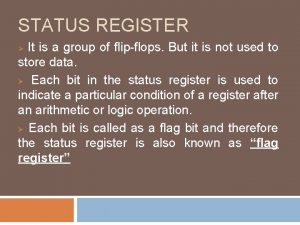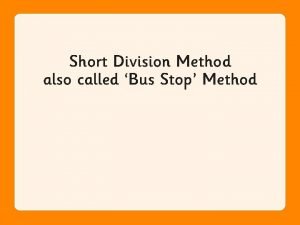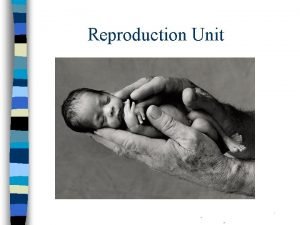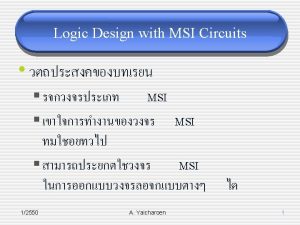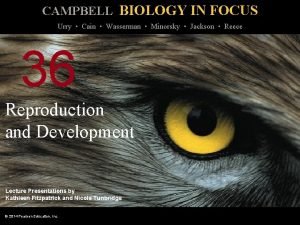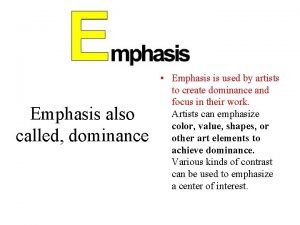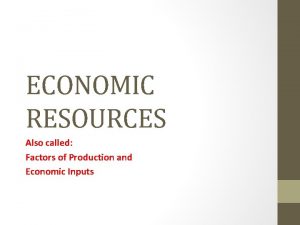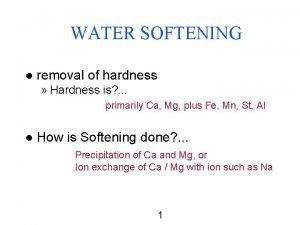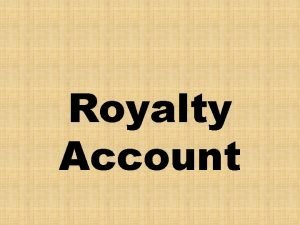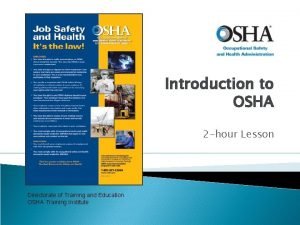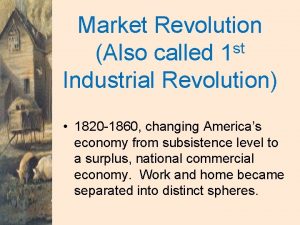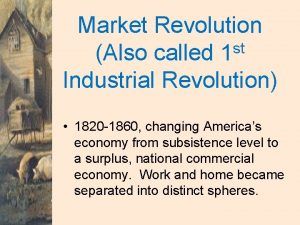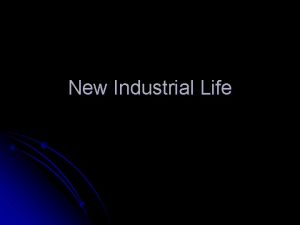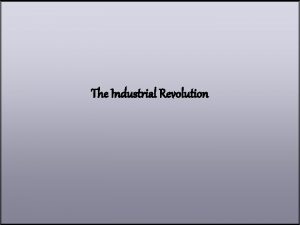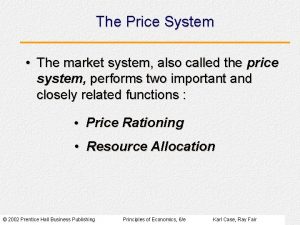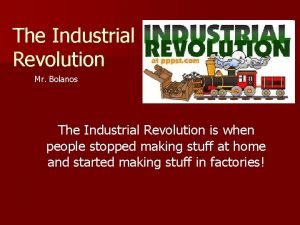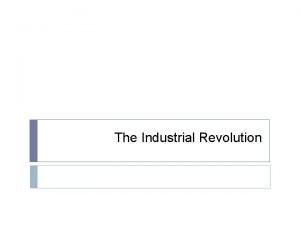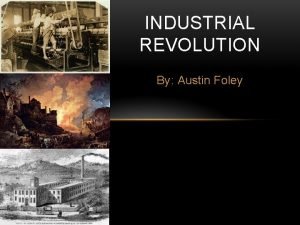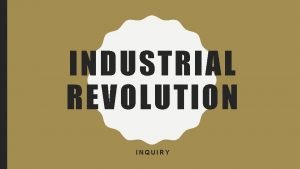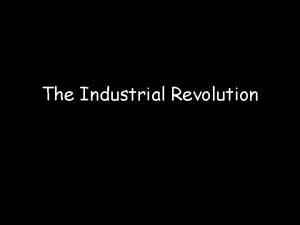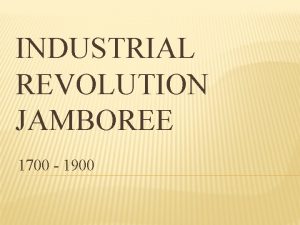Market Revolution st Also called 1 Industrial Revolution








































- Slides: 40

Market Revolution st (Also called 1 Industrial Revolution) • 1820 -1860, changing America’s economy from subsistence level to a surplus, national commercial economy. Work and home became separated into distinct spheres.

• Some historians have argued that the economy that emerged after the War of 1812 constituted an industrial revolution. • Support, modify, or refute this contention using specific evidence.

What was government’s role? Jefferson’s Vision of America Role of Govt. v Patents protect inventions v Private Property Rights v Marshall Court decisions v American System v Hamilton’s Vision of America v Bank v Internal Improvements-State projects v Tariffs: Protect manufactures Let Capitalism work: Laissez-Faire Economics

I. Inventions: Yankee Ingenuity Eli Whitney’s Cotton Gin, 1791 50 x faster than hand, saved slavery, responsible for its growth


Whitney’s Gun Factory Interchangeable Parts Rifle

Cyrus Mc. Cormick- mechanical reaper

• John Deere: steel plow broke thickly matted soil of the West • Telegraph -- Samuel F. B. Morse • Sewing Machine- perfected by Isaac Singer

II. Transportation Revolution – Between 1825 and 1855, cost of transportation fell 95%, bringing new regions into the market • Canals, steamboats, better roads, covered wagons, Clipper ships,

First Turnpike Lancaster, PA (1790) By 1832, nearly 2400 mi. of road connected most major cities.

Cumberland “National Road, ” 1811

Conestoga Covered Wagons Conestoga Trail, 1820 s

Yankee Clipper Ships

Robert Fulton & the Steamboat – Revolutionized transportation in the West, especially on the Miss. River from 1820 -60 (Not used on canals!!) The Clermont

The Canal Age • Erie Canal, “Clinton’s Ditch” completed in 1825, became model for other states to follow • States fund projects • Canal era dramatically lowered costs of transportation • By 1850’s, RR replace canals • Caused NYC to be the Port of the nation, replacing New Orleans

15 Miles on the Erie Canal… • http: //www. epodunk. com/routes/ erie-canal/index. html#

The Erie Canal- Bruce Springsteen • • I've got a mule, and her name is Sal, Fifteen miles on the Erie Canal She's a good old worker and a good old pal Fifteen miles on the Erie Canal We haul'd some barges in our day Filled with lumber, coal, and hay We know every inch of the way From Albany to Buffalo. Low bridge, ev'rybody down Low bridge, we're comin' to a town You'll always know your neighbor and you'll always know your pal If ya ever navigated on the Erie Canal. A friend of mine once got her sore Now he's got a broken jaw 'Cause she let fly with an iron toe and kicked him back to Buffalo We'd better look around for a job, old gal Fifteen miles on the Erie Canal You can bet your life I'll never part with Sal Fifteen miles on the Erie Canal Get up mule, here comes a lock We'll make Rome 'bout six o'clock One more trip and back we'll go Right back home to Buffalo Where would I be if I lost my pal? Fifteen miles on the Erie Canal I'd like to see a mule as good as my Sal Fifteen miles on the Erie Canal Low bridge, ev'rybody down! Low bridge, we're comin' to a town You'll always know your neighbor You'll always know your pal, If ya ever navigated on the Erie Canal. Low bridge, ev'rybody down! Low bridge, we're comin' to a town


• III. John Marshall and the Promotion of Enterprise: – Body of rulings in all, strengthen the power of the federal government and establish a pro-business atmosphere • Mc. Culloch v. Maryland (1819) (Blow to states' rights) 1. Issue: Maryland tried to destroy its branch of the BUS by taxing its notes. 2. Marshall declared BUS constitutional invoking Hamilton's doctrine of implied powers (elastic clause of the constitution – "necessary & proper"). • Gibbons v. Ogden, 1824 ("steamboat case") (Blow to states' rights) 1. Significance: Only Congress had the right to regulate interstate commerce. 2. Issue: NY tried to grant a monopoly of river commerce between NY & NJ to a private company (owned by Ogden). Gibbons had congressional approval to conduct business on the same river. 3. Court ruled interstate rivers were to regulated by Congress, not individual states.

Fletcher v. Peck (1810) (protection of property rights against popular pressures) 1. Issue: new Georgia legislature canceled a contract which granted 35 million acres in the Yazoo River country (Miss. ) to land speculators as a form of graft. -- Previous legislature had made the grant in what was called "Yazoo Land Controversy” during Jefferson’s presidency. 2. Significance: Court ruled Constitution forbids state from "impairing contracts". Dartmouth College v. Woodward (1819) (protection of property rights from the states) 1. Issue: New Hampshire had changed a charter granted to the college by the British king in 1769. Republicans sought to remove "private" aspect of school & make it a state institution. -- Dartmouth appealed; defended by Daniel Webster, an alumnus. 2. Ruling: Charter was a contract; states could not invalidate it.

IV. The Rise of Factories • Samuel Slatersmuggles industrial technology to America, 1791 Pawtucket, R. I. • Lowell – 1 st workers women, later replaced by immigrants • Industrial Work


• Textile Industry sparked Industrial Revolution in the U. S. (during War of 1812) • 1814, Francis Cabot Lowell built first dual-purpose textile plant at Waltham, Mass. • Lowell Girls: Local farmers' daughters hired to work in the factories – More independence for young women – Lowell promised strict moral supervision and mandatory church attendance. • Irish and German immigrants replaced Lowell Girls; worked for very low wages

V. Regional Specialization East • More industrial; made machines and textiles for other two regions • By 1861, owned 81% of U. S. industrial capacity. • Most populous region; 70% of manufacturing workers South: • Cotton for export to New England Britain; slavery • Resisted change to its economy and culture • Some industrial growth but output never exceeded 2% value of cotton crop West: • Became nation’s breadbasket: Grain and livestock • Fastest growing population Political implications • Two northern sections (East and West) closely interconnected economically


VI. Social Structures of the Market Society • Materialism- people valued for their possessions • The Emerging Middle Class • The Distribution of Wealth- increased social stratification: Rich vs. Poor • Women’s new roles – Economic Specialization – Decline of women’s traditional work – New ready-made men’s clothing reduced amount of sewing women did

• The Federal Land Rush • Geographic Mobility • Population Explosion, doubling every 25 years • New Immigrants: German and Irish • New Urbanization, West, St. Louis and Cincinnati


• Evaluate the relative importance of domestic and foreign affairs in shaping American politics in the 1790’s.

• To what extent was the election of 1800 aptly named the “Revolution of 1800”? Respond with references to TWO of the following areas: – Economics – Foreign Policy – Judiciary – Politics

– Economics • Overall economy: Yes, barter to market economy shift • Fed gov econ policy, not so much – TJ cut spending of army and navy, debt in ½, removed excise tax, Embargo 1807 killed foreign trade, kept bank, but his Party promoted later became Federalist like, American System (Bank, Internal improvements, & high protectionist Tariff) – Foreign Policy • Big switch from loyalty from Federalist of GB (Jay’s Treaty, XYZ, Quasi-War) to Republican France loyalty (LP, War 1812), but lots of Neutrality mixed in – Judiciary • Big change, but in Federalist direction, midnight judges Marbury v. Madison, Judicial review, Jefferson wanted state’s to have this power in his Virg. & Kent. Resolutions Mc. Culloch v. Maryland, expand federal implied powers, – Politics • Big Change, Federalist never Prez again, die of b/c Hartford Convention, Era of Good Feelings, 1 party rule

• Although the power of the national government increased during the early republic, this development often faced serious opposition. Compare the motives and effectiveness of those opposed to the growing power of the national government in TWO of the following: – Whiskey Rebellion (1794) – Virginia and Kentucky Resolutions (17981799) – Hartford Convention (1814 -1815)

• Analyze the contributions of TWO of the following in helping establish a stable government after the adoption of the Constitution – George Washington – John Adams – Thomas Jefferson

– George Washington • Domestic – Hamilton’s Financial Program, cabinet and 2 term tradition, Whiskey Rebellion put down, character • Foreign – Neutrality Proclamation, Pinkney’s Treaty, Jay’s Treaty, Farewell Adress – John Adams • Domestic – VP for GW, Alien & Sedition Acts • Foreign – XYZ Affair, Quasi War w/ France, Convention of 1800 – Thomas Jefferson • Domestic – Created political parties, opposed Bank, VP for Adams, authored state’s right nullification idea in the Virg. & Kent. Resolutions, Revolution of 1800 election, Tecumseh & Indian assimilation, removed excise tax on whiskey, let Alien & Sedition Acts expire, paid down debt, cut Navy & Army • Foreign – Lou. Purchase. , Embargo 1807, Non-Intercourse Act, Barbary Pirates

• “Developments in transportation, rather than manufacturing and agriculture, sparked American economic growth in the first half of the nineteenth century. ” • Assess the validity of this statement

• Analyze how THREE of the following helped bring about a shift from an agricultural to an industrial economy in the United States in the first half of the 1800’s. – commercial farming – factory system – US government – transportation – labor

– commercial farming • Cotton Gin, Steel Plows, Mechanical reapers, Cotton, West grain, bread basket, surpluses sold at the market – factory system – • NE textiles, water power, Slater smuggles info in, Lowell Girls, – US government • American System, Embargo, protectionist tariffs, laissez-faire economics, patents, contracts, LLC – transportation • Canals (Erie), steamboats west, clipper ships int. trade, turnpikes, national road, covered wagons, RR – Labor • Women- Lowell Girls, replaced by immigrants, people moving from the farms, slaves

• In what ways did developments in transportation bring about economic and social change in the United States in the period 1820 to 1860?

• “The United States experienced an Era of Good Feelings from 1815 to 1825. ” -Assess the validity of this statement. • Make sure you consider the issues of nationalism and sectionalism

 Market leader follower challenger nicher
Market leader follower challenger nicher Difference between segmentation targeting and positioning
Difference between segmentation targeting and positioning Alfred webers theory
Alfred webers theory Blind search in artificial intelligence
Blind search in artificial intelligence Citric acid cycle also called
Citric acid cycle also called Specification-based techniques
Specification-based techniques Trachea is also called
Trachea is also called A workbook is also called a
A workbook is also called a Spider phylum
Spider phylum Glasses also called eyeglasses (formal)
Glasses also called eyeglasses (formal) It is also called figurative language
It is also called figurative language Why are diphthongs known as gliding vowels
Why are diphthongs known as gliding vowels Tca cycle meaning
Tca cycle meaning Locomotor movement in dance
Locomotor movement in dance Alkanes are also called
Alkanes are also called Status register is also called as
Status register is also called as Short division bus stop method
Short division bus stop method Womb is also called
Womb is also called Advantages of raster scan display
Advantages of raster scan display Data selector is also called
Data selector is also called Circle graph is also called
Circle graph is also called Womb is also called
Womb is also called Dynamic and formal equivalence
Dynamic and formal equivalence Womb is also called
Womb is also called Womb is also called
Womb is also called 4 adjacency and 8 adjacency pixels example
4 adjacency and 8 adjacency pixels example Womb is also called
Womb is also called Bit stuffing and byte stuffing difference
Bit stuffing and byte stuffing difference Single phase full wave ac voltage controller with rl load
Single phase full wave ac voltage controller with rl load Shark class
Shark class A brief work of fiction is also called a
A brief work of fiction is also called a Also known as dominance
Also known as dominance What are capital resources examples
What are capital resources examples Direct method criticism
Direct method criticism Physiological density ap human geography definition
Physiological density ap human geography definition Antihaemorrhagic vitamin
Antihaemorrhagic vitamin Permanent hardness is also called as
Permanent hardness is also called as What is short working in accounting
What is short working in accounting Modals are also called
Modals are also called What are the osha construction standards also called
What are the osha construction standards also called 1910-1200
1910-1200


